Physical Address
304 North Cardinal St.
Dorchester Center, MA 02124
The genitourinary (GU) tract is especially prone to anatomical and morphological variations, and successful intervention relies on careful anatomical appreciation and planning. This chapter describes the various interventional procedures currently used in the GU tract but commences with a review of the anatomy relevant to renal access, as this is the cornerstone of most GU interventions.
The kidneys lie in the perinephric space at the level of T12 to L2/L3 vertebral bodies. The upper pole is more medial than the lower, with a coronal axis tilt of approximately 15 degrees. The upper pole is also more posterior facing than the lower. In the short axis the renal pelvis points anteromedially. Anatomical disposition in the three planes is illustrated in Fig. 85.1 .
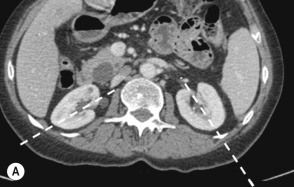
The important relations regarding renal access are those adjacent structures that may be inadvertently injured—the liver, spleen, diaphragm, pleura/lung and the colon. Variant anatomy should also be remembered: for example, the splenic flexure of the descending colon may be abnormally high and posterior (said to be more common in obese women). Pre-procedure ultrasound (US) will identify these hazards.
The adult kidney has approximately eight to nine calyces. Typically, the upper and lower pole calyces are fused and therefore larger and easier to access. Calyces will also vary in orientation, facing either relatively anterior or posterior. The posterior calyx is ideal for access, being closer to the skin surface. Posterior calyces also allow better intrarenal navigation; for example, the route from a posterior to an adjacent anterior calyx or the renal pelvis is more or less in a straight line forward. However, access to the pelviureteric junction (PUJ) and ureter is easier from an interpolar or upper pole calyx. These points are illustrated in Fig. 85.2 .
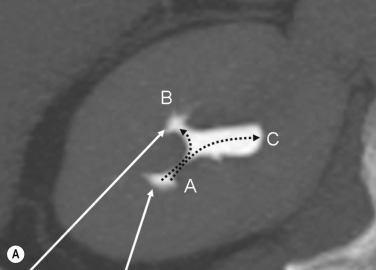
The main renal artery divides into a (larger) anterior division and smaller posterior division, and each division further separates into segmental and lobar divisions ( Fig. 85.3 ). Peripherally, the lobar and arcuate arteries skirt around the calyx. Thus the safest place to puncture a calyx is its middle. Puncture into the infundibulum or renal pelvis may lacerate larger arterial branches. A further potential hazard is the posterior division, which is the only major renal arterial division that lies posterior to the collecting system. Typically it lies behind the upper renal pelvis, but occasionally it is behind the upper pole infundibulum, where it may be injured if entry is misdirected towards the infundibulum rather than the upper pole calyx. Normally there is a single renal artery and vein, but up to 25% of kidneys have more than one renal artery and variant renal veins are seen in 3% to 17%. These do not influence access but may explain the occasional vascular injury that occurs despite adherence to safe anatomical principles.
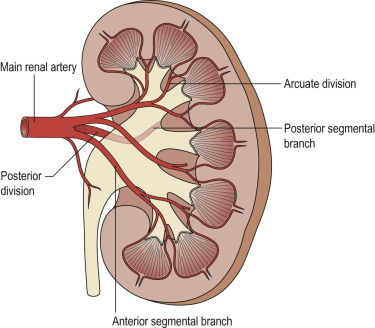
Part of either kidney will lie above the eleventh/twelfth rib, especially the left kidney, and upper pole access may require an intercostal entry, placing the intercostal artery or pleura at risk. The intercostal artery runs in a groove underneath the rib and is vulnerable with angled cephalad needle puncture. The posterior reflection of the parietal pleura is horizontal and reflected off the lateral portions of the ribs, and puncture through the latter half of the intercostal space is theoretically safer ( Fig. 85.4 ).
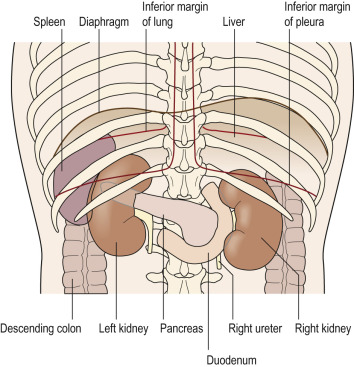
From this discussion, it can be appreciated that there are numerous factors to consider when planning safe, effective percutaneous renal access. The important considerations are summarised in Table 85.1 . The safest point for calyceal puncture is the centre of the calyx, approached through the relatively avascular plane (Brödel line) between the branches of the anterior and posterior divisions of the renal artery. Puncturing the centre of the calyx avoids injury to the arcuate divisions that course around the infundibulum. This is the ideal and is illustrated in Fig. 85.5 .
To summarise: A lower pole, posterolateral puncture of the centre of the calyx, is theoretically the safest. The upper pole is more posterior and allows for easier navigation but must be approached with due care. |
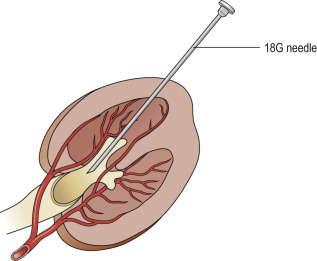
Personal preference may determine the choice of equipment, but some general principles can help guide selection.
The two broad choices are a one-part 21-G needle system (sometimes known as a micropuncture access system) or a one-part 18-G/4-F sheath system . With the former, the puncture is with a 21-G needle, through which a 0.018-inch, platinum-tipped wire is inserted, followed by a 4-F dilator and finally a 0.035-inch working guidewire . A one-part system is an 18-G diamond point needle, over which is placed a 4-F sheath and the whole is inserted as a single unit . The puncture size is smaller with the two-part system (21-G vs. 18-G or 0.032-inch vs. 0.048-inch diameter) and should be safer, but this has not been proven.
The ideal puncture site is the centre of a calyx, but the calyx is a small structure with a usually even smaller outlet. Thus to navigate out of the calyx, a soft flexible wire with good torque is important, whereas rigidity is less vital. We favour either a straight-tipped Bentsen wire or an angled-tipped hydrophilic wire. With the former wire, the floppy tip should not be too long. Once the guidewire has been manipulated out of the calyx (ideally down into the ureter, or at least into the renal pelvis), rigidity becomes more important, and a stiffer Amplatz-type wire is useful, especially if the track is being dilated for percutaneous nephrolithotomy (PCNL) or a stent is being inserted through a malignant stricture. A stiff shaft hydrophilic wire has particular merits, being both rigid and kink resistant, whereas the other guidewires can kink. Kinks impede catheter advancement and lead to rupture of the renal pelvis. The standard diameter is 0.035 inch, but thinner wires, especially with stiff inner cores (e.g. nitinol core), can be useful with tight ureteric strictures.
Used for either navigation or drainage. For the former, a short angled-tip (e.g. Kumpe) or Cobra shape, high-torque catheter is best. Hydrophilic catheters are useful for bypassing tight ureteric strictures. For drainage, a pigtail catheter with large holes along the inner surface of the pigtail is chosen, as these are less likely to obstruct once the system decompresses. Any size > 6 F should suffice, but the pigtail may not easily form in a small renal pelvis. The location and size of the drainage holes in the pigtail ensure good drainage. The pigtail should assist anchorage, especially with a locking system, but they do still fall out, and we routinely also further secure them in place (see later). Drainage catheters less frequently used are straight catheters or those with a Malecot-type tip, both useful with the small renal pelvis.
Percutaneous nephrostomy (PCN) insertion is a commonly performed interventional procedure, most frequently for the relief of renal obstruction, with or without associated infection, and some further indications are listed in Table 85.2 .
|
Ideally, a nephrostomy should be performed within working hours, on a stable, well-resuscitated and monitored patient. However, it is also important not to unnecessarily delay renal decompression, especially in those with suspected pyonephrosis or infected hydronephrosis, because these patients can rapidly deteriorate. The only two published randomised studies comparing nephrostomy and ureteric stents showed them to be equally effective. The technical success rate for PCN is quoted as 98–99% of patients, but it is possible that previous series may have underrepresented non-dilated kidneys as the success rate is reduced in patients with non-dilated collecting systems, complex stone disease or staghorn calculi. Available practice guidelines quote a success rate of 98% for dilated systems and transplants and 85% for non-dilated systems and staghorn calculi.
There are no absolute contraindications to performing a PCN. Severe coagulopathy is a relative contraindication, but this can be corrected. In patients with a limited life expectancy, a nephrostomy should be inserted only if this would lead to improved quality of life and survival. In all cases a multidisciplinary approach and close liaison with referring clinicians are essential.
Written consent should be obtained for all PCNs. Acceptable thresholds for complications are listed in Table 85.3 . Where local complication rates are known, these should inform the consent process. Intravenous access and adequate hydration should be established; metabolic acidosis and hyperkalaemia should be corrected. A normal coagulation profile, with an International normalised ratio (INR) <1.3 and platelet count of >80,000/dL, should be ensured. Antibiotic prophylaxis should be given, especially if there is clinical evidence of infection. A single dose of a wide-spectrum agent is sufficient for low-risk patients. In high-risk cases (elderly, diabetic, indwelling urinary catheter, bacteriuria, ureteroenteric conduit), antibiotics may have to be continued and modified appropriately once urine culture results are known.
| Complication | Incidence (%) |
|---|---|
| Septic shock requiring major increase in level of care | 4 |
| Septic shock (in setting of pyonephrosis) | 10 |
| Haemorrhage requiring transfusion | 4 |
| Vascular injury (requiring embolisation or nephrectomy) | 1 |
| Bowel transgression | <1 |
| Pleural complications | <1 |
| Complications resulting in unexpected transfer to an intensive care unit, emergency surgery or delayed discharge | 5 |
Insertion is usually performed in the prone or prone oblique position. A true lateral or supine/oblique position is feasible; however, this increases the technical difficulty, with a greater risk of trauma to the liver, spleen or bowel. Computed tomography (CT) guidance may help if there is concern about variant anatomy. The procedure is usually performed under monitored sedoanalgesia. In addition, a local anaesthetic agent is infiltrated down to the renal capsule. Occasionally, when dealing with a confused or restless patient, it may be safer to perform the procedure with the assistance of an anaesthetist, who can maintain a deeper level of sedation with safety, whilst the interventionist focuses on performing the procedure.
Following puncture of an appropriate calyx, a small amount of urine is aspirated to confirm the position of the needle. If the urine is clear, and the patient does not demonstrate any signs of sepsis, a small volume of iodinated contrast medium (approximately 10 mL) is injected into the collecting system. Overdistension should be avoided as this greatly increases the risk of bacteraemia. If the puncture site is acceptable, a guidewire is inserted and the track dilated for catheter insertion (single puncture PCN— Fig. 85.6 ). If the puncture site is revealed to be unsuitable (i.e. entry is into an infundibulum or the renal pelvis), then a second puncture should be performed into a more suitable calyx (double puncture PCN—see later).
Ensure that the indication for a nephrostomy is appropriate
Evaluate all preprocedure imaging to ensure that there is no unexpected anatomical variation
Ensure preprocedure antibiotics and hydration
No guidance method is of proven superiority and should be chosen according to local circumstances and whether the system is dilated or not. However, whichever method is chosen, the calyx should be approached following the principles laid out in Table 85.1
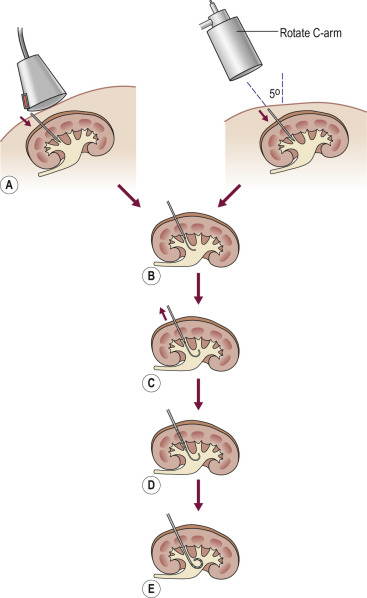
On US, the posterior calyces are the most superficial and medial with the patient lying prone. With advances in US equipment and technique, primary puncture of a target calyx has become more common and is usually uneventful in a dilated system, allowing for a single puncture PCN.
Intravenous iodinated contrast medium can be used to opacify and select a suitable calyx. On fluoroscopy of an opacified collecting system, the calyces that demonstrate the largest range of movement when viewed on continuous screening (with tube below couch) from +30 to −30 oblique positions are the most posterior calyces. Being non-dependent, posterior calyces will be also be the least densely opacified in a prone position. Double contrast pyelography can also be used to highlight the posterior calyces as any gas (air or CO 2 ), being buoyant, will preferentially gravitate into the non-dependent parts of the collecting system. Not more than 20 mL of gas should be injected slowly and under continuous fluoroscopy. Care should be taken to avoid gaseous extravasation into the surrounding tissues, vessels or the retroperitoneum. Once a suitable calyx is identified, the needle is inserted under fluoroscopic guidance ( Fig. 85.7 ).
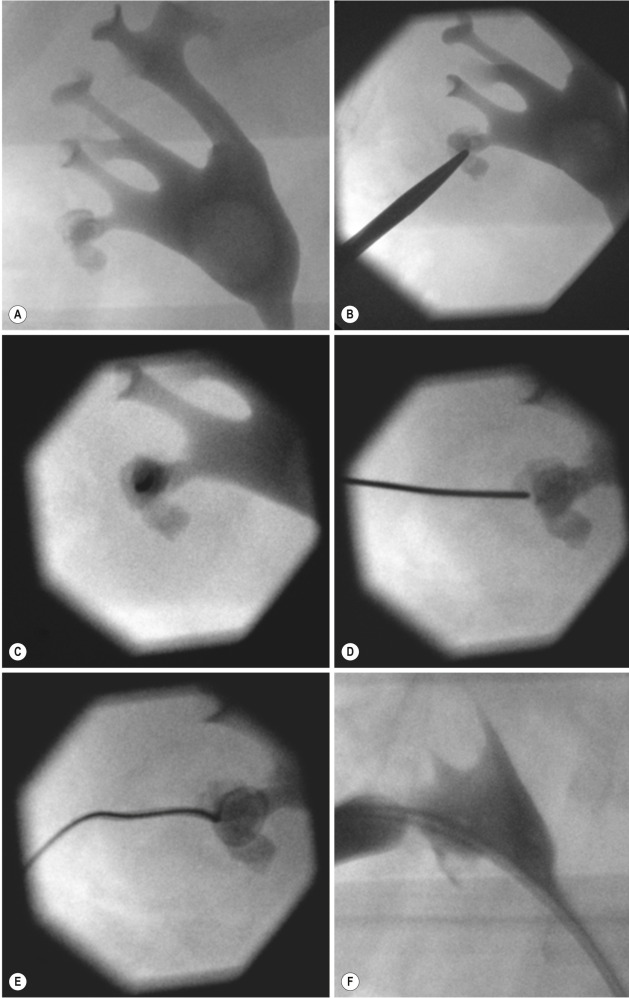
The collecting system is initially punctured under US guidance. Ideally the definitive calyx for PCN should be punctured and subsequent tract dilatation and catheter insertion carried out under fluoroscopic guidance. However, if definitive calyceal entry is not feasible (e.g. when the calyces are small), then any part of the collecting system visualised on US is entered with a 22-G needle, a single or double contrast pyelogram is performed and the pyelographic information used to select a target calyx. The chosen calyx is then punctured under fluoroscopic guidance, the tract dilated and a catheter inserted.
This technique is useful and safer when variant renal anatomy is suspected (e.g. horseshoe kidney, pelvic kidney or suspected retrorenal colon). A planning pyelographic phase CT is performed in the prone or supine/oblique position. The procedure can be performed under sole CT guidance or as a combined CT/fluoroscopy method. Needle access is gained under CT guidance, and a guidewire is inserted. Subsequent tract dilatation and catheter insertion is done under fluoroscopic control. For the latter, care should be taken to ensure the access is secure before transferring the patient to the interventional suite ( Fig. 85.8 ).
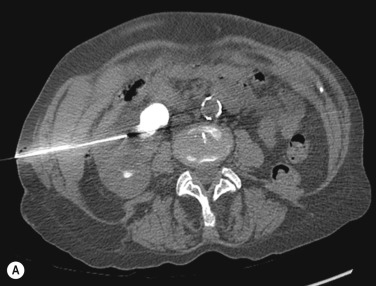
Displacement of a nephrostomy catheter is a constant hazard, particularly with long-term drainage. Definitive management (e.g. ureteric stenting) should not be delayed. The catheter should also be meticulously secured. Most nephrostomy tubes have a self-retaining suture, which, once pulled, forms a ‘locked’ pigtail within the collecting system. However, anchorage is not guaranteed, and we further secure the tube to the skin ( Fig. 85.9 ). A single anchoring suture through skin should be made close to the tube entry site. A small piece of tape is secured around the tube. The suture is then wrapped around the tube in a ‘Roman sandal’ configuration with knots at every turn going away from the skin entry site. The suture should be firmly tightened against the catheter but not so tightly as to kink the tube. Once the top of the tape is reached, the suture is returned towards the skin entry site, as a reversed ‘Roman sandal’ pattern. In addition, we apply a standard ‘drain-fix’ dressing.
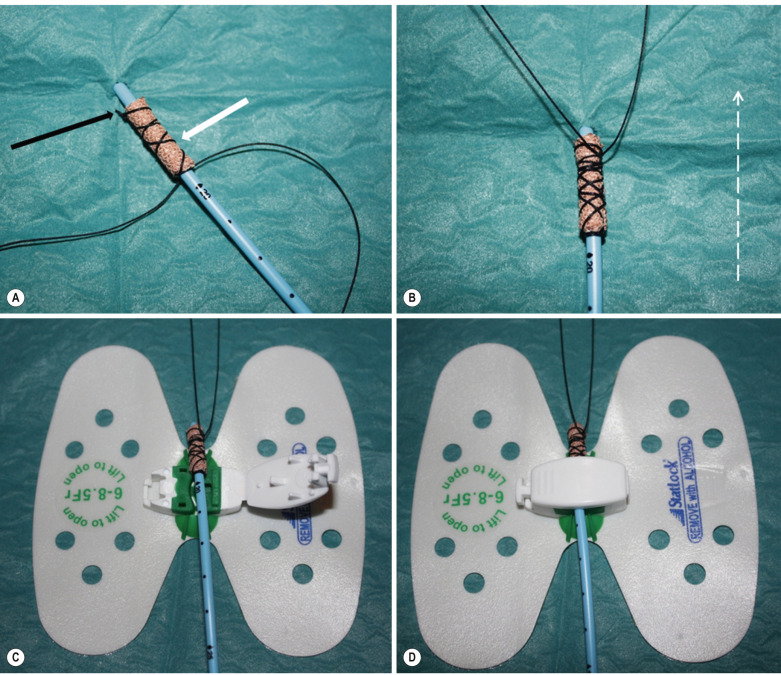
Removal of a nephrostomy tube should be performed under fluoroscopic control and using a guidewire. The pigtail should be unlocked, and, if this fails, the nephrostomy tube can be cut at the hub; however, this increases the likelihood of the suture being caught in the soft tissues on withdrawal of the nephrostomy tube, leaving a fragment behind. A retained suture acts as a foreign body and a nidus for stone formation. Therefore it is preferable to unlock the catheter whenever possible and not to cut the suture.
Non-dilated calyces are not visualised on US examination, and, being small, they are difficult to puncture. In addition, the space is too restricted for wire/catheter manipulation. The double contrast technique can be used in these cases. If the renal pelvis can be seen on US, then this can be punctured with a 22-G needle and a double contrast pyelogram performed to identify and distend the posterior calyces. If no part of the collecting system can be seen on US, then intravenous contrast medium is used to opacify the system and a posterior calyx selected and punctured. Using this technique, a success rate of up to 96% can be achieved in the non-dilated system.
Because of its anatomical disposition, the horseshoe kidney is prone to impaired drainage, infection and stone formation, but the orientation of the calyces and vessels are such that percutaneous access is relatively safe. As horseshoe kidneys are located more inferiorly, the upper poles are usually well below the ribs. The lower pole and pelvis are usually more anterior facing, and a lower pole lateral entry may damage large anterior division arteries or accessory branches from the iliac artery. Thus a medial lying, upper pole calyx entry should be chosen for PCN ( Fig. 85.10 ).
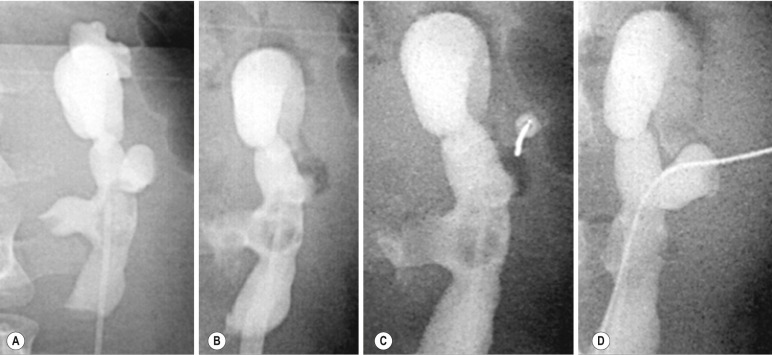
Become a Clinical Tree membership for Full access and enjoy Unlimited articles
If you are a member. Log in here